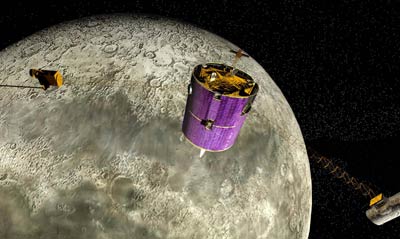Lunar Reconnaissance Orbiter: the cornerstone of the visionby Taylor Dinerman
|
| It can be assumed that the primary goal of this project is to map the Moon’s usable resources for planning ISRU technologies. |
The meaning of the data from the 1994 Clementine and 1998 Lunar Prospector missions is still being debated. We know, for example, that there is plenty of hydrogen on the Moon, but we do not know what form it is in or what it is chemically bonded with. It would be nice if the LRO can confirm or deny the presence of water ice in the dark craters of the south polar region. Choosing the right instruments to do this should be at the top of any list of priorities.
Water is the second most valuable substance in the solar system (the most valuable, of course, being human brainpower.) In his April 1st testimony before the House Science Committee, Paul Spudis said that, “We estimate that over 10 billion tons of water exist at the lunar poles.” If he’s right, then the vision to build the Moonbase, to perfect ISRU technology and then go on the Mars, will be possible within roughly the time frame laid out by President Bush. If the water is not there, or if it is there in forms that make it difficult to extract, then the whole project will need to be rethought.
There are a number of other imperatives for the LRO instrument package. It must include instruments to produce a detailed topographic map of the whole lunar surface. This means that a state-of-the-art laser altimeter must be included. There must also be a pan- chromatic one-meter resolution or less imager, and a multi- or hyperspectral sensor. Magnetometers and some sort of ground penetrating radars are also desirable.
It is not likely that a suitable instrument suite can be made to fit inside the 40 or 50 kilo payload capability of a Delta 2. In order to put a probe into lunar orbit, enough propellant must be included so that the spacecraft can slow itself down. Unlike Mars, where the thin Martian atmosphere allows for aerobraking maneuvers, all of the energy needed to move into a capture orbit must be brought along from Earth in the form of hydrazine or another type of fuel.
| Since the people who handle space budgets inside the Pentagon are desperate to see more EELVs fly, it is likely that they will be willing to look for innovative ways to help the LRO onto a more powerful rocket. |
If NASA plans to launch LRO on a Delta 2, as most observers assume, the payload limits will probably ensure that the limited data that will be transmitted back to Earth will not be enough to accomplish the mission’s most important goals. If, on the other hand, they decide to upgrade to an Atlas V or Delta IV EELV class vehicle, the mission design team will be able to put together an instrument package that will weigh in at 120 kilos, or more. This, along with enough fuel to maintain a low altitude orbit around the moon, will produce a spacecraft that will accomplish all the main objectives.
Upgrading from a Delta 2 to an EELV will probably not cost more than 10 or 15 million dollars. Since the people who handle space budgets inside the Pentagon are desperate to see more EELVs fly, it is likely that they will be willing to look for innovative ways to help the LRO onto a more powerful rocket. In the case of the LRO, the more fuel it can carry the better.
ESA’s SMART-1 mission is on its way to the Moon, and Japan has two missions planned: Lunar A, to be launched in September of this year and Selene, whose launch date is planned for August 2005. The data from these missions will be helpful, but they are not geared towards gathering resource inventory data for ISRU. Only the LRO is specifically designed for this mission.
This is critically important to the vision, since the Moon is only the first place that such an inventory will be taken. If LRO is done right, we will have a model for the future. If it is done wrong, not only will this be a waste of time and money but it will put the whole vision plan into jeopardy. Getting this right the first time will require proper funding and superb mission management. This will be a test that NASA, Code T, as well as the Administration and Congress, dare not fail.
